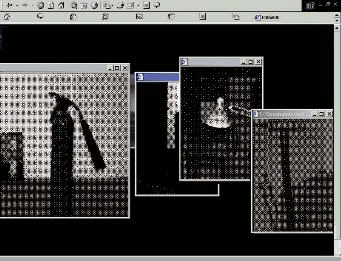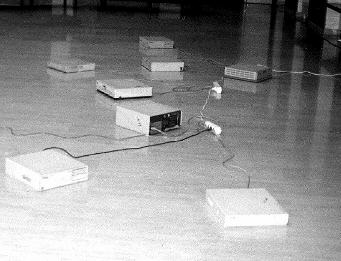





SMS Mediated Sublime, Installazione interattiva (computer, telefoni cellulari, videoproiezione), Rocca Sforzesca, Imola, 2006. Courtesy Musei Civici di Imola.
|
SMS Mediated Sublime
(SMSMS), 2000- |
|
"Pensavo a grandi immagini capaci di evolvere reagendo da sole e istantaneamente a messaggi inviati dagli spettatori via telefono. Tuttavia non volevo che queste immagini si adattassero semplicemente alle scelte dell'ultimo spettatore, ma che tenessero conto delle scelte di tutti, come in certe tecniche di democrazia elettronica. Volevo sperimentare un’arte generativa, interattiva e pubblica, usando non la semplice interattività ma il decision-making interattivo, cioè la democrazia......." Installazioni interattive che chiunque può modificare dal proprio telefono cellulare. Alcune IMachines sono collegate alla rete telefonica mobile per consentire al pubblico di modificare le caratteristiche delle immagini attraverso l’invio di SMS (la prima serie è iniziata con il progetto SMSMS-SMS Mediated Sublime, 2000). I flussi di comunicazione (struttura iterativa e feedback) sono simili a quelli usati in applicazioni di democrazia elettronica. Nella seconda serie (CIMs-Collective Intelligence Machines), l'installazione è costituita da più postazioni distinte, distanti, coordinate attraverso la rete telefonica. Interactive installations which everybody can modify by using a cell phone. Some IMachines are connected to the mobile phone network. This allows the audience to modify some characteristics of the images in real time, by sending SMS messages (the first series started with the SMSMS-SMS Mediated Sublime project, 2000). The communication structure (iterations and feedback) is similar to that of e-democracy applications. In the second series (CIMs-Collective Intelligence Machines), the installation is made up of two or more different and distant locations, coordinated across the telephone network. |
 SMSMS (SMS Mediated Sublime), Installazione interattiva (computer, telefoni cellulari, videoproiezione). Courtesy Art Palace, Cairo, 2008.
|
| "Especially interesting are participation technologies taken from electronic democracy (such as real time opinion-convergence techniques and interactive decision-making) which are based upon three main features: recursive structure, feedback and statistical response [...]: in interactive installations (for example the CIMs), this means that anybody can continually change their mind and send new inputs, can see the corresponding output in real time, and in so doing they contribute to decisions that start up new cycles of images with different characteristics. Up to now those who have dealt with interactive media installations have concentrated on human-machine communication (vertical interaction), neglecting any form of so-called collective intelligence (horizontal interaction). I think that this could be now reconsidered to produce a leap in quality in interactive art: a change from interaction to interactive decision-making, that is from interaction to democracy. A point that I’d like to emphasise is that a generative process based on these techniques can be even more surprising and obscure than a generative process based solely on software. I think this opens up the possibility of generative art which is interactive and public, in which even the instability and the technical limitations of participation devices (which in this context are bound to be used and misused, open to everyone) can represent an interesting aspect. I am thinking of installations at the crossroads between generative art, public art and mobile electronic democracy (participation technologies via mobile communication)........" (MB) from C. Hope, J. C Rian, Digital Arts: An Introduction to New Media, Bloomsbury, New York 2014, ch. 9: "Maurizio Bolognini revises the very notion of a digital device to encompass hardware, software and the public. Postdigital artists see digital devices as enmeshed in social processes and patterns. For Bolognini, ‘neo-technological art’ (his preferred term for new media art) refers to a heterogeneous field that coalesces around the pillars of art, technology and activism, reinforcing the social dimension of the science art alliance. New modes of participation offer a variety of possibilities for digital art in which there is a shift from weak modes of public interaction to stronger modes that promote democracy and public decision-making. [...] To be sure, digital art in the future will utilize participatory technologies and mobile communications to a greater extent. It is the pervasiveness of digital technology in our everyday lives that underpins the postdigital character of art. Bolognini argues that the shift to the postdigital occurs as practices go beyond early experimental phases and enter mainstream circulation. For example, software is now routinely used in art and design, making the notion of ‘software art’, including software-based art and programming aesthetics, somewhat outmoded (unless, of course, the history of the genre is being considered). For Bolognini, the first stage of ‘neo-technological art’ was marked by experimentation and research, followed by a period of ‘diffusion’ in which the distinction between media art and media technology collapses. Moreover, ‘generative art’ (another post-media aesthetic in Manovich’s terms [...]) allows artists to set out the rules followed by devices that are designed to operate autonomously. Here, Bolognini distinguishes between ‘device-oriented generative practices’ (which use software in experimental ways aligned with early media art) and ‘outcome-oriented generative practices’ (which prioritize final products rather than creative processes and are aligned with the rather non-experimental diffusion phase mentioned above). [...] As an interdisciplinary prospect, a postdigital future lies in a dynamic zone beteen the digital and material, the real and the constructed, the sign and the referent. Artist and critic Mel Alexemberg in The Future of Art in the Postdigital Age echoes the social emphasis of Mark Tribe and Maurizio Bolognini in defining postdigital art as “of pertaing to art forms that address the humanization of digital technologies through the interplay between digital , biological, cultural and spiritual systems, between cyberspace and real space...”from
Thomas Nail,
Theory of the Image, Oxford University Press, Oxford 2019, p. 352:
|
|
ICB (Interactive Collective Blue) / Democratic
Blues , 2006 |
|
"I Democratic Blues sono una serie di quadri blu che documentano la sequenza di colori prodotti dall'installazione ICB (Interactive Collective Blue) realizzata collegando alla rete telefonica mobile una macchina programmata per generare variazioni di luce blue (usando il modello di colori RGB). Il pubblico poteva modificare continuamente i valori RGB, fino a raggiungere un certo grado di consenso su un ristretto numero di Blu democratici. Ogni quadro di questa serie indica al centro della campitura blu il numero di round impiegati per ottenere il consenso del pubblico e i valori RGB del colore rappresentato......."
|
|
|